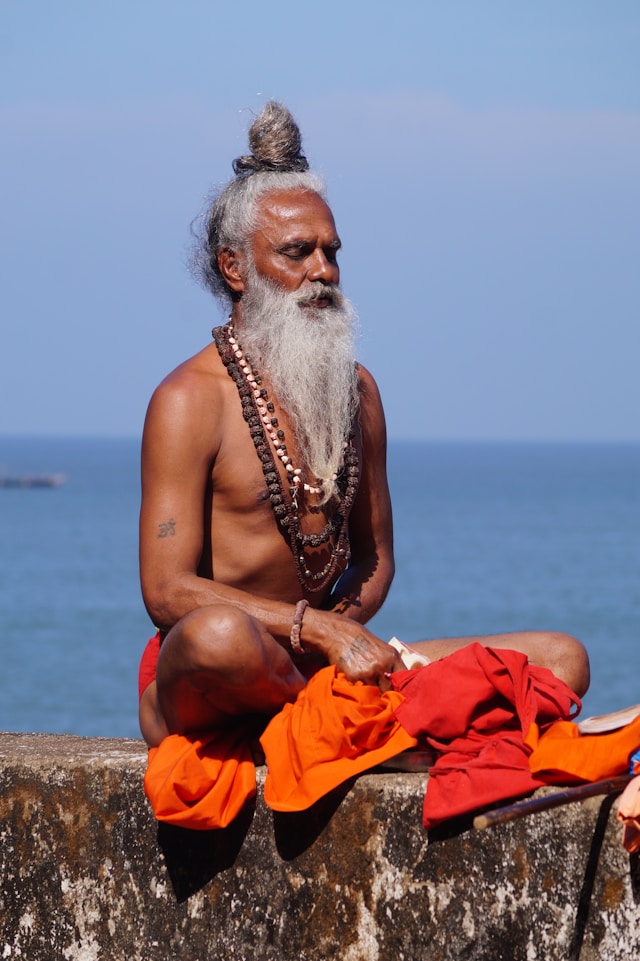When I consider my journey through spirituality and physical wellness, I see Buddhism and Yoga not as distinct paths but as threads woven from the same fabric. I have found a profound connection between these two practices. Both originated in the rich, cultural tapestry of ancient India, each with its own philosophies, teachings, and practices to guide individuals towards inner peace and self-realization.
Understanding how Buddhism and Yoga complement each other is not just an exercise in theoretical exploration; it’s about discovering practical ways these age-old teachings can enrich our modern lives. Their intersection points to a wellspring of wisdom that supports a balanced approach to mental, physical, and spiritual well-being.
In this article, I will walk you through the crossroads where Buddhism and Yoga intersect. We’ll trace their historical ties, examine their philosophical underpinnings, delve into their meditative practices, explore the physical aspect of each path, and consider how both have adapted to the modern world. Finally, you’ll receive actionable advice on integrating these practices into your daily routine to cultivate a more mindful and compassionate existence.

Historical Harmony: Tracing the Links Between Buddhism and Yoga
To appreciate the connection between Buddhism and Yoga, I turn to their common origins. Both blossomed from the fertile cultural and spiritual soil of ancient India, drawing from a well of philosophical thoughts and practices that date back thousands of years.

Historical evidence points to a deep intertwining between these disciplines. Yoga’s formative text, the Yoga Sutras of Patanjali, and key Buddhist scriptures share notable similarities in concept and language, suggesting a mutual influence during their early development.
Buddhism and Yoga didn’t develop in isolation; they absorbed and reflected elements from each other. As Buddhism spread, it carried strains of yogic practice, which evolved within its own framework. Conversely, Yogic schools often incorporated Buddhist elements into their teachings, demonstrating a fluid exchange of ideas.
What’s fascinating is that while Buddhism nurtured its own meditative and ethical systems, it did so on a parallel track to the flourishing yogic traditions. This parallel evolution suggests they were different rivers flowing from the same source, intermingling at various junctures of their journeys.
Philosophical Parallels: Core Concepts That Bind
I often find it fascinating how separate practices can echo the same truths. Take Buddhism and Yoga, for example. At their philosophical hearts, they share profound similarities. Both aim for enlightenment and liberation. Buddhists strive for Nirvana, a release from the cycle of rebirth and suffering. Yogis seek Moksha, liberation from the same cycle. These goals tell of the profound resonance between the two systems.
Ethical precepts are the threads that weave through the fabric of both Buddhism and Yoga. Non-violence, known as Ahimsa in the Yogic tradition, is a principle that practitioners uphold devoutly, promoting peace and respect for all living beings. Similarly, Buddhism calls for non-harm as part of its Eightfold Path. Truthfulness, or Satya, is another shared value urging honesty and integrity.
Then there’s the concept of suffering, or Dukkha in Buddhism, which asserts that suffering is intrinsic to life but can be overcome through the path laid out by Buddha. Yoga’s philosophical texts echo this, highlighting that ignorance of our true nature leads to suffering but can be transcended through Yogic practice.
Transience is another shared belief. Both paths recognize that change is the only constant. Attachment to impermanent things leads to suffering; hence, detachment is prescribed—a theme in the teachings of both Buddha and Patanjali, the sage behind the Yoga Sutras.
Naturally, such philosophical overlap paves the way for practical application, specifically in how we approach the mind and consciousness. The next section, ‘Meditative Mindscapes’ will show just how Buddhism and Yoga use meditative practices as tools for transformation.
Meditative Mindscapes: Shared Techniques and Goals
When I strip both Buddhism and Yoga back to their essence, I find meditation standing firmly at the intersection. It’s the core practice where their paths not only cross but align, offering a unified direction towards heightened awareness and inner peace.
Mindfulness—or ‘sati’ in Pali, the language of the early Buddhist texts—is central to Buddhist practice. It’s about maintaining a moment-by-moment awareness of our thoughts, feelings, bodily sensations, and the surrounding environment. Yoga approaches this with ‘dhyana’, fostering a deep, contemplative focus. Though the terminology differs, the experience they allude to is unmistakably similar: a state of concentrated awareness.

Breath, posture, and focus have a pivotal role in both Yoga and Buddhist meditation. In Yoga, the breath is closely linked to movement and the energy flow through ‘prana’. In Buddhism, breath is often the object of meditation itself, guiding the practitioner into deeper levels of mindfulness. Even the famed ‘lotus’ position originates from a need for stable seating during lengthy periods of meditation, a shared requirement across the traditions.
But it isn’t just about sitting still; it’s about what these practices cultivate within. Both Buddhist meditation and Yoga meditative states aim to carve out a space free from the chatter of the mind. This mental clearing allows for a blossoming of insight; it’s like holding up a mirror to the mind, reflecting its true nature.
The transformative power of meditation found in these spiritual traditions isn’t confined to the cushion or mat—it extends into actionable mindfulness practices that can permeate the way I engage with the world. It’s a rich soil from which compassion, a key tenet of Buddhism, grows, and it steels the inner resolve that is developed through the diligence of Yoga.
As I transition into examining the physical practices of these paths, I can’t help but consider how the mindful awareness nurtured in meditation becomes the heartbeat of physical movement in Yoga. The next section will delve into this bodily connection and how the physical practices of Yoga can serve as a conduit for the meditative principles of Buddhism. They intertwine, creating a holistic approach not only to spirituality but also to well-being.
Bodily Bonds: The Physicality of Practice
While the spiritual pursuits often steal the spotlight, the physical practices form a bridge between Buddhism and Yoga that can’t be ignored. In Yoga, the postures, known as asanas, are staples of the practice. Although traditionally Yoga is more than just these physical exercises, these asanas have been adopted in various forms within Buddhist practices, especially in Tibetan traditions where they are used to prepare the body for prolonged meditation.
Engaging in the physical practices of Yoga can aid in the Buddhist goal of spiritual awakening. Just as the body supports the mind in achieving dhyana, or absorption, the discipline of regular physical practice supports the quest for enlightenment. The Buddha himself spoke of the Middle Way, a path of moderation away from the extremes of self-indulgence and self-mortification, and Yoga’s physical dimension can manifest this balance.
Delving into how energy, body, and consciousness interact reveals further intersections. For instance, the concept of prana in Yoga, the vital life energy that flows through the body, reflects the notion of ‘prana’ or ‘lung’ in Buddhism, which moves through channels in the body to support health and spiritual development. Harnessing this energy through asanas and meditation can lead to profound changes in one’s physical and spiritual well-being.
Whether you’re seated in a lotus position or moving through a sequence of sun salutations, you’re engaging in a practice that transcends the physical. These motions and stillnesses also align with Buddhist practices, encouraging a deeper exploration of the self and leading to insights that might have otherwise remained elusive.
In the next section, I’ll guide you through the Contemporary Convergence of these two ancient disciplines. As the world increasingly seeks out wisdom from the past to address contemporary challenges, understanding how Buddhism and Yoga adapt and thrive in the modern world becomes all the more relevant.

Contemporary Convergence: Buddhism and Yoga in the Modern World
When I look at the modern landscape, it’s clear that Buddhism and Yoga haven’t just survived the test of time; they’ve thrived, evolving to meet the needs of a global audience. The ancient wisdom of quieting the mind and opening the heart is now accessible to anyone seeking solace from the frenetic pace of modern life.
What started as a counter-culture movement in the ’60s has burgeoned into a full-fledged wellness revolution. People around the world attend Yoga classes that not only teach postures but often incorporate elements of Buddhist mindfulness and meditation into the practice.
This synergy isn’t accidental. Yoga studios are adapting, and teachers are increasingly aware of the benefits of merging the mental clarity from Buddhist practices with the physical strength gained from Yoga. It’s a holistic blend that caters to the wellness-minded individual.
Furthermore, the digital age has ushered in unprecedented access to these traditions. There are countless apps for meditation, online Yoga classes, and virtual retreats that draw heavily from both paths. This has made such practices more inclusive, surpassing geographical and cultural borders.
Yet, the fusion of Buddhism and Yoga in contemporary culture is not without its critics. Purists argue that the depth of each practice can be diluted when combined for commercial appeal. There’s a fine line between respectful adaptation and the loss of profound philosophical roots.
Despite these challenges, there’s an opportunity here. It’s a chance to create a space where the essence of both Buddhism and Yoga can be preserved while still embracing innovation that reaches a wider audience. From a personal development perspective, this evolution offers a rich soil for growth.
Walking the Path: Integrating Buddhism and Yoga in Personal Practice
You’ve explored the historical, philosophical, and practical layers of Buddhism and Yoga, and now you’re likely considering how to weave this ancient wisdom into your everyday life. Aligning the two doesn’t demand perfection or an all-or-nothing approach; it’s about finding balance and harmony within your practice.

Start small by setting aside time each day for mindful breathing, acknowledging the breath as the link between body and mind, a concept cherished by both traditions. Incorporate meditation into your Yoga routine or explore Yoga poses during your Buddhist practice to understand how they complement each other.
Listen to the experiences of long-time practitioners. Many share their stories online and in books, offering you guidance on merging these paths. These narratives can serve as both inspiration and practical advice, showing you the diverse ways in which Buddhism and Yoga can enrich your journey.
Foster the qualities of mindfulness and compassion—centrepieces of both Buddhism and Yoga. These are not just practices for the mat or cushion; carry them into the way you interact with others, handle stress, and confront challenges. The true integration happens off the practice mat, in the fabric of daily life.
Remember, the purpose is not to blur the lines and lose the essence of each tradition, but to honour and use their strengths in ways that enhance your overall well-being. Give yourself the flexibility to adapt and personalize your practice, making it a reflection of your unique path.



